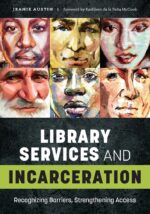Providing Library Services to the Incarcerated
An Interview with Jeanie Austin on Their New Book
 Providing library services to people held in prisons and jails can be a challenging endeavor. Those who take on this work will need to navigate complex, and not always welcoming, corrections’ bureaucracies and face censorship or be themselves co-opted into censoring in ways that are antithetical to the ethical tenets of librarianship. Yet the information needs among incarcerated and detained people are immense given their limited access to the internet or other technologies (if they have any at all) and under-resourced and often understaffed prison libraries.
Providing library services to people held in prisons and jails can be a challenging endeavor. Those who take on this work will need to navigate complex, and not always welcoming, corrections’ bureaucracies and face censorship or be themselves co-opted into censoring in ways that are antithetical to the ethical tenets of librarianship. Yet the information needs among incarcerated and detained people are immense given their limited access to the internet or other technologies (if they have any at all) and under-resourced and often understaffed prison libraries.
In a new book published by the American Library Association, Jeanie Austin of the San Francisco Public Library explores the place of libraries and librarians within the American carceral system and provides practical information for those wishing to provide services to the country’s millions of incarcerated and detained people. Here we explore what motivated them to write the book, the impact they hope it will have, and what issues are currently top of mind for providing library services to incarcerated people.
Please introduce yourself and tell us what motivated you to develop this new book?
 I research library services and incarceration and am an active jail librarian with San Francisco Public Library’s Jail and Reentry Services. I’ve maintained a hybrid approach to this work (one might call it a form of praxis) for over a decade, dating back to my time as a juvenile detention center librarian and Master’s student at the iSchool at the University of Illinois at Urbana-Champaign. As a Master’s, and later PhD student, I was often the only person in my courses insisting on the need for Library and Information Science (LIS) to consider the impacts of incarceration on information access. I needed a firm foundation for making these arguments, and I found this largely outside of the field, particularly in critical theory developed in Black and Ethnic Studies and Gender and Women’s Studies. I was also fortunate to be mentored by scholars incorporating critical theory and social justice into LIS coursework, including Safiya Noble, Miriam Sweeney, and Nicole A. Cooke.
I research library services and incarceration and am an active jail librarian with San Francisco Public Library’s Jail and Reentry Services. I’ve maintained a hybrid approach to this work (one might call it a form of praxis) for over a decade, dating back to my time as a juvenile detention center librarian and Master’s student at the iSchool at the University of Illinois at Urbana-Champaign. As a Master’s, and later PhD student, I was often the only person in my courses insisting on the need for Library and Information Science (LIS) to consider the impacts of incarceration on information access. I needed a firm foundation for making these arguments, and I found this largely outside of the field, particularly in critical theory developed in Black and Ethnic Studies and Gender and Women’s Studies. I was also fortunate to be mentored by scholars incorporating critical theory and social justice into LIS coursework, including Safiya Noble, Miriam Sweeney, and Nicole A. Cooke.
In part, the book is an extension of my early classroom efforts to draw from interdisciplinary studies. While theoretically informed, it is also an attempt to reduce the barriers that librarians in the field face when they begin to consider incorporating information about incarceration into library programs or find themselves as a new hire at a carceral institution. It does this by stepping back from assumptions that LIS professionals understand the complicated carceral system, even down to the difference between jails and prisons. While it is informed by the writings of other jail, juvenile detention, and prison librarians (including Brenda Vogel and Glennor Shirley), as well as research conducted by academics, it differs from some of the works that precede it because it aims to create a more holistic picture of the many ways that incarceration and LIS intersect.
What are three major takeaways you hope readers will come away with?
My first hope is that readers will see that the types of conceptual differences LIS professionals might imagine exist between incarcerated people, people negatively impacted by incarceration and library patrons are largely fiction. Librarians are, whether they are explicitly aware of it, already serving patrons negatively impacted by incarceration. This is the aftermath of decades of mass incarceration.
Equally, I hope that LIS professionals recognize that there are many opportunities to increase library services for incarcerated people. I’m aware that LIS professionals in public institutions face severe budget and staffing restrictions, which is why I’ve been sure to emphasize that some of these opportunities, such as Reference by Mail services, do not involve a large infrastructural shift to implement. I’ve also encountered academic, public, and special librarians who are seeking to increase incarcerated people’s information access but do not have administrative support to do so. This is why Books to Prisoners groups, which are often administered through volunteer efforts, are also highlighted.
Librarians in jails, juvenile detention centers, and prisons are notoriously isolated and don’t often have time or the other resources needed to participate in professional networks. I hope that librarians doing this work, especially those who aspire to increase information access for incarcerated people, find themselves as part of a loose, but extant, network of like-minded peers.
How do you think the library profession could or should support increased information access among incarcerated people? What are the three most acute needs among this patron group?
The vast majority of people who are incarcerated are not able to access the Internet, which is a pressing issue as many materials that were once in print are now born digital. I often find myself reflecting on what information I have accessed online at the end of the day, and the ways that access has increased my knowledge, allowed me to connect to others, or simply provided a self-affirming diversion. This disconnect not only affects people while they are incarcerated–it has ramifications for whether they are able to access information after they are released. This is why I have dedicated a chapter of the book to the topic of technology, information access, and incarceration.
That said, many incarcerated people across the country lack access to even basic reference material. This is an acute need. The dictionary has been and remains the resource that incarcerated people are most likely to request. How might librarians/libraries facilitate access to foundational reference materials such as this?
Librarians and libraries who are unable to directly or indirectly provide access to currently incarcerated people can work in collaboration with them to raise general awareness of incarceration and its impacts. Incarceration is a total experience–it shapes the life of incarcerated people during, and if released, after their incarceration. This is a stark reality, but it means that librarians working in all kinds of fields–academic, medical, or public, to name a few–are positioned to raise awareness of how incarceration intersects with their specialization.
What trends are you seeing concerning providing library services to incarcerated people? Which are you most hopeful about, most concerned?
LIS professionals and students are much more engaged with the topic of incarceration than, in my experience, they were a decade ago, which leads me to believe there may be a real sea change in the amount of services available to incarcerated people. Preliminary findings of Chelsea Jordan-Makely’s ongoing research with the Library Research Service at Colorado State Library suggest this is the case. Efforts through Reginald Dwayne Bett’s Freedom Reads, PEN America, and, of course, Ithaka S+R are also heartening. To me, this is not only evidence of a response to mass incarceration but also suggests a shift in how people who are not incarcerated conceptualize the humanity of incarcerated people and the ethical issues at play in the American system of incarceration.
Do you have any new or upcoming projects in this area?
While writing the book, I became increasingly interested in an historical analysis of LIS and incarceration. I unearthed documents that were otherwise left by the wayside, finding a richer history and tradition than I had imagined. I recently spent a week in the American Library Association Archives, digitizing records related to library services and incarceration. My next step is to pore over the archival record and piece together when, how, and why this area of librarianship has become of interest to the field as a whole.
It also became clear to me while undertaking this project that very, very little is known about what library services exist and how they are implemented. There is a real need to understand the landscape of information services to incarcerated people so that we are better able to see what is being offered and where gaps in service exist. Relationship and network building are also a critical part of this work and having a clear view of this landscape will help practitioners make connections more easily. We are currently in conversations with funders about doing this work, so I hope to be able to share some good news soon!
Comments
Can't wait to have this book. Please put in more datas as needed. Thank you.
Providing such education to all incarcerated individuals will increase their confidence and will motivate them to do good in their lives.